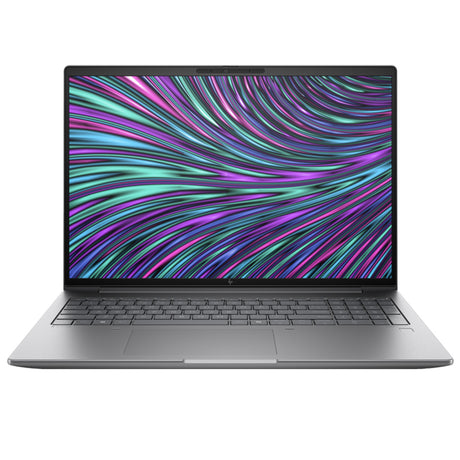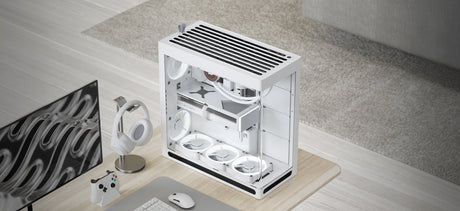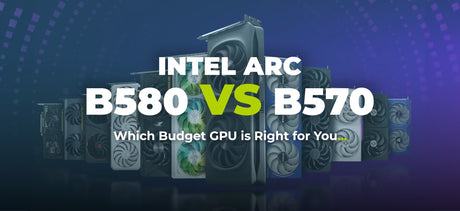Why TOPS and NPUs Matter when Shopping for your Next PC
While researching before buying a new PC, you will often come across technical terms, or acronyms that leave you with more questions than answers, and the latest of those terms are likely ‘NPUs’ and ‘TOPS’, with ‘TOPS’ being the new marketing buzzword in this new era of AI PCs. If you’re not sure what these acronyms mean, fret not – we're here to explain. Let's delve into the significance of TOPS and the role of NPUs. Why these factors should factor into your decision-making process when choosing your next PC.
What Does TOPS Mean?
TOPS stands for ‘Trillions of Operations Per Second’; This metric gauges a computer's processing capability in operations per second, for demanding tasks such as artificial intelligence (AI), machine learning, and data analysis. The higher the TOPS value, the better equipped your PC is to handle complex operations efficiently without experiencing slowdowns. It's akin to the engine power of your computer – more TOPS translates to better performance and productivity.
How Do You Ensure your PC’s Performance is Top of the TOPS?
You’ve likely heard of CPUs (Central Processing Units), and GPUs (Graphics Processing Unit), both of which play a role in the computational workload of AI tasks, but in order to efficiently crunch though AI workloads, microprocessor manufacturers such as AMD and Intel have developed a specialised chip called an NPU (Neural Processing Unit). Users can call on the power of these NPUs to leverage neural networks for anything from mundane data entry tasks, to locally-hosted generative AI through large language models (LLMs), or image generation models. While these AI models often don’t rely exclusively on the NPU, they are generally the drivers behind the impressive TOPS figures you encounter in modern top-of-the-line computers.
An NPU can manage multiple data streams simultaneously, making it well-suited for tasks like image recognition, understanding natural language, and making predictive analyses. This capability is especially significant in a world where AI is increasingly integrated into everyday applications ranging from voice assistants to smart home gadgets.
Although NPUs represent an advancement and continue to enhance speed and efficiency with each new iteration, particularly when compared to CPUs, they are not the ultimate solution for achieving peak performance. For tasks requiring speed, such as 3D rendering, intricate simulations, or scientific computations, GPUs still reign supreme.
GPUs are specifically engineered to handle large amounts of data concurrently, which makes them perfect for operations demanding extensive parallel processing. In these scenarios, the sheer power of GPUs remains unparalleled by NPUs or CPUs.
Where NPUs become increasingly valuable is in portable devices, where battery life is paramount. AI workloads that will drain system resources when run on the GPU or CPU, can be allocated to the NPU, resulting in significantly-less power draw. NPUs are becoming increasingly essential in high-performance PCs alongside GPUs rather than replacing them. As AI technology advances, having a PC equipped with an NPU that delivers the required TOPS is crucial for handling complex AI functions seamlessly.
Comparing TOPS to Established Performance Metrics
You may have come across different performance metrics, such as GHz (gigahertz) for CPU speed or FLOPS (Floating Point Operations Per Second) for mathematical calculations. While these metrics are crucial, TOPS offers a comprehensive gauge of your PC's capability to manage modern AI-related tasks.
Is it Important to Factor in TOPS and NPUs When Purchasing a PC?
Absolutely! If your job or interests revolve around AI, machine learning, intricate simulations, or any other intensive computing tasks, evaluating the TOPS rating and the presence of an NPU in your PC is vital. These aspects will provide insight into how your PC can handle both current and upcoming workloads.
However, it's essential to remember that TOPS are just part of the picture. You should also take into account components like the GPU, RAM, and storage to ensure that your PC is suited for all your requirements.
Microsoft Copilot+ PCs
With all the popularity surrounding AI chatbots, and other forms of generative AI, Microsoft have introduced a new category of Windows PCs, designed specifically for the era of AI computing. They have called this category of PCs ‘Copilot+ PCs’. Copilot+ not only indicates the presence of an NPU in the system, but it is also a standard of performance that means that the system delivers at least 40 TOPS of AI-compute performance.
Concluding Remarks
In essence, TOPS are an emerging benchmarks for a PC's capacity to tackle today's data-heavy tasks as well as those on the horizon. As AI and machine learning technologies continue to influence the technology landscape, having a grasp of these metrics can assist you in selecting a computer that is not only high-performing but also future-proof. Therefore, when comparing specifications, it's important not to concentrate solely on traditional metrics such as CPU speed. Make sure to also consider the TOPS rating and NPU capabilities. Despite the nature of NPUs, it's essential to remember that GPUs still hold the upper hand in terms of sheer power, particularly for tasks like 3D rendering or scientific computations. Striking the right balance among these components could significantly impact your next PC investment.




















